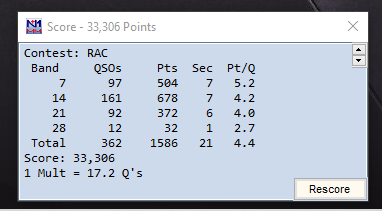 2022 RAC contest in the rearview mirror
2022 RAC contest in the rearview mirror
The Radio amateurs of Canada (RAC) winter contest has come and gone for 2022. This contest is both CW, AM, FM and SSB. As for me, it was the same old same old just CW. The propagation gods were smiling on this contest and conditions were great. I operated 7 hours on Saturday they were 1-hour sessions with about a 10 min break at each end of hour. I find this works best for me and I set in a lunch and or dinner time as well.
The radio, software and antenna worked great no complaints at all. The system I find works best for me is to start out searching and pouncing contacts. This gets in the log those who are only running in the contest and also it gets my ears warmed up to the code speed. I then move on to running which in this contest I did about 90% of the time. The participation was great and while running my best 1-hour count was 91 QSOs which kept me very busy and the hour flew by.
There were nice openings on all the bands my Hustler 4BTV provided for me 10,15,20 and 40m. The settings I find that work best for me on the Icom 7610 are;
Filter set to 400Hz so I can hear those that call a bit off frequency I find that 250 or less a bit too narrow. Now having said that during the "biggy" contests 250Hz is required due to the close proximity of signals.
I keep my APF (audio Peak Filter) on and set it to wide.
I keep the NR (noise reduction) on and set it to a low range.
I use the CW full break in and it does take some getting used to. As you transmit dits and dahs your rig goes back and forth from receive to transmit. This allows me to hear if anyone is trying to contact me while transmitting. You would be shocked at how many times I hear someone. Also when searching and pouncing as you call a station it allows you to hear if another station is also trying to make contact. In that case, I just stop transmitting as it would be just a mixed mess being sent to the station. Also, it allows you to hear if the running station is contacting someone and then you just stop transmitting as you don't want to QRM.
Below are the end results of 7 hours on the air I am very pleased with the numbers and I am getting more confident in my contest running abilities.
Mike Weir, VE9KK, is a regular contributor to AmateurRadio.com and writes from New Brunswick, Canada. Contact him at [email protected].
 ICQ Podcast Episode 392 – Choosing a Hand Held / Handie Talkie
ICQ Podcast Episode 392 – Choosing a Hand Held / Handie Talkie
In this episode, we join Martin Butler M1MRB, Chris Howard (M0TCH), Martin Rothwell (M0SGL), Frank Howell (K4FMH), Bill Barnes (WC3B) and Leslie Butterfields (G0CIB) to discuss the latest Amateur / Ham Radio news. Colin Butler (M6BOY) rounds up the news in brief and in the episode's feature is Choosing a Hand Held / Handie Talkie.
We would like to thank our monthly and annual subscription donors for keeping the podcast advert free. To donate, please visit - http://www.icqpodcast.com/donate
- New General Question Pool Released for Ham Radio Licensing
- Radio Amateur Earns PhD in Electrical Engineering
- Museum of Information Explosion
- New Record Set on Lowest Ham Band in Australia
- Future of the BBC as Presented by Director-General Tim Davie
- Santa is On the Air Via Ham Radio
- John Hislop (G7OHO) joins RSGB’s Examinations and Syllabus Review Group
- CAMSAT XW-4 (CAS-10) Satellite To Be Deployed
Colin Butler, M6BOY, is the host of the ICQ Podcast, a weekly radio show about Amateur Radio. Contact him at [email protected].
 AmateurLogic 176: A Very Merry Christmas
AmateurLogic 176: A Very Merry Christmas
AmateurLogic.TV Episode 176 is now available for download.
Tommy uses Chirp open source software to program his transceiver. Emile discusses a tactical net in the Slidell area using Amateur Radio, GMRS and FRS.
No ALTV Christmas episode would be complete without some comic entertainment. In the spirit of the season we present ‘Cheap Old 2022 Rear End Review’ and ‘AmateurLogic.TV Crazy Cheap Close-Out’.
George Thomas, W5JDX, is co-host of AmateurLogic.TV, an original amateur radio video program hosted by George Thomas (W5JDX), Tommy Martin (N5ZNO), Peter Berrett (VK3PB), and Emile Diodene (KE5QKR). Contact him at [email protected].
 Amateur Radio Weekly – Issue 266
Amateur Radio Weekly – Issue 266
KrakenSDR locates a repeater jammer in 1 hour
Using the KrakenSDR Radio Direction Finder, we were the jammer’s house in 60 minutes.
RTL-SDR.com
WTWW signs off permanently
Some programming moves to WRMI.
CQ Newsroom
I used modern digital modes and I have mixed feelings
I will be honest though, I am kind of stuck in the past.
WK4DS Amateur Radio Blog
What ever happened to Ramsey Electronics?
On November 10th 1999, Ramsey Electronics of Victor, New York, was raided by the United States Customs Service.
AE5X
How to find out if your common mode current choke really works
Due to the skin effect current can flow along the inner surface of the coax shield as well as the outer surface.
Ham Radio Outside the Box
Listening for the CAS-5A Chinese satellite at 435 MHz
It’s an unusual satellite in that it has transponders with a downlink in the 70cm band and uplinks on the 2m VHF band and the 15m HF band.
EI7GL
Where VOA’s broadcast infrastructure stands today
Shortwave retains a role in serving particularly difficult-to-reach audiences.
Radio World
Why scan?
The content that can be heard on scanners is, on occasion, astonishing.
SWLing Post
Video
10m Contest recording
Featuring VR2XAN, ZL4CZ, EI7M, HS0ZET.
PB4ES
Sam Mulvey shows you how to FM radio
All about setting up the low-power FM radio station KTQA in Tacoma, WA.
Hackaday
HAM
Get to know the culture of Montana radio enthusiasts and their deep passion for ham radio.
PBS
Does my old screen door tune?
What I do with anything metal: See if it tunes as an antenna.
AI6YR
Get Amateur Radio Weekly in your inbox.
Sign-up here
Amateur Radio Weekly is curated by Cale Mooth K4HCK. Sign up free to receive ham radio's most relevant news, projects, technology and events by e-mail each week at http://www.hamweekly.com.
 RAC Survey 2022 now available
RAC Survey 2022 now available
Dave Goodwin, VE3KG, RAC Regulatory Affairs Officer at the Radio Amateurs of Canada, has just posted the results of the 2022 RAC Survey on their website. It was my honor to work with RAC to analyze the data and draft the technical report. The executive team at RAC is a delight to work with: they just want to get the best answer from the data. That’s what every organization should desire so that effective policy can be made. That is why I volunteered a considerable amount of my time to work with this team.
The map above depicts amateurs in the current Canadian database of certifications (licenses), regardless of when it was granted. Thus, there are likely many Silent Keys represented in the map. But it is the universe that must be the starting point. They are quite spatially concentrated, no? But they are no doubt conversely as diverse as hams are in other countries as well. This means we must have solid, reliable data in order to make the optimal policy recommendations on their behalf. RAC takes this mission to heart.
The issues surrounding call signs in Canada is the focus of the 2022 RAC Survey. I invite you to use the links above to take a look, or even a careful reading, of the technical report. Dave Goodwin put a good Canadian spin on my Americanized spelling and offered questions that help any statistician improve a draft report. Otherwise, David and Phil McBryde VA3QR, RAC President, left the analysis to me, a professional survey researcher and statistician.
The Regulatory Team at RAC consists of Dave Goodwin, VE3KG, Paul Coverdale, VE3ICV, Bryan Rawlings, VE3QN, Glenn MacDonell, VE3XRA, Richard Ferch, VE3KI and Serge Bertuzzo, VA3SB. They have done great work here! I look forward to other collaborations with RAC. You can find out more about this team’s efforts on behalf of amateur radio in Canada at their YouTube presentation embedded below.
And, oh, I just renewed my RAC membership for 2023! I encourage you to do the same.
Frank Howell, K4FMH, is a regular contributor to AmateurRadio.com and writes from Mississippi, USA. Contact him at [email protected].
 LHS Episode #493: The Weekender C
LHS Episode #493: The Weekender C
It's time once again for The Weekender. This is our departure into the world of hedonism, random topic excursions, whimsy and (hopefully) knowledge. Thanks for listening and, if you happen to get a chance, feel free to call us or e-mail and send us some feedback. Tell us how we're doing. We'd love to hear from you.
73 de The LHS Crew
Russ Woodman, K5TUX, co-hosts the Linux in the Ham Shack podcast which is available for download in both MP3 and OGG audio format. Contact him at [email protected].
 Microphone Hanger for Backpacks
Microphone Hanger for Backpacks
My standard SOTA setup is a Yaesu FT-90 compact VHF/UHF transceiver stuffed into a fanny pack with its Bioenno battery pack. The fanny pack is a pretty nice flyfishing pack that I position on the front side of me so I can easily see and operate the radio. I am usually holding the 2m or 70 cm Yagi antenna and talking on the microphone.

I’ve been looking for a way to clip the microphone onto the pack. Typically, what happens now is I drop the microphone and it gets banged up when it hits the rocky ground. I needed a way to easily hang it on the side of the pack. I recalled having an old cellphone belt clip that accepts the standard button on the back of a mobile microphone, but I couldn’t locate it. However, I did find one on Amazon.

I clipped it onto my fanny pack and the Yaesu microphone hangs quite nicely on it. This clip can be used for other applications…anywhere you want to hang a microphone onto a backpack, belt, or whatever. Depending on your station configuration, this may be useful for all kinds of portable operating: SOTA, POTA, and satellites.
73 Bob K0NR
The post Microphone Hanger for Backpacks appeared first on The KØNR Radio Site.
Bob Witte, KØNR, is a regular contributor to AmateurRadio.com and writes from Colorado, USA. Contact him at [email protected].

















